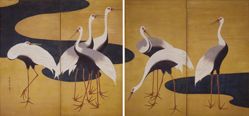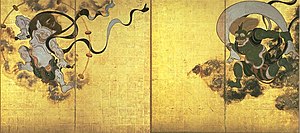I had the chance last year to see an interesting exhibit on the artwork of the Rinpa School at the Tokyo National Museum. Beginning in the Edo Period with artists like Ho'onami Koetsu and Tawaraya Sotatsu, members of this school recursively worked on themes developed by previous members of the school, in a variety of mediums including painting, calligraphy and maki-e lacquer ware.
Rinpa artists took these works and developed them in each successive generation, creating interesting and fresh takes on themes like the Wind & Thunder Gods or Cranes Dancing in a Field. Ho’nami for instance looked to to the Heian Era for inspiration and used classical Chinese models for his calligraphy, many times overlaying them onto paintings and ceramics done by others. This interleaving of arts across mediums and reimagining them across time is a hallmark of the school for me.
For those who’ve read Yoshikawa Eiji’s classic novel “Musashi”, Ho’onami makes an appearance early on, encouraging the young swordsman to explore his aesthetic side.
Ho’onami’s sometimes collaborator Tawaraya Sotatsu revived the classic Yamato-e style of painting and created the iconic “Wind and Thunder Gods” (Fujin to Raijin) for Kennin-ji Temple in Kyoto. As is usual for major shows at museums, the painting was far more compelling in its original setting at Kennin-ji contemplated in solitude on a tatami mat the week before, than jostling in a sea of patrons at the exhibit.
This exhibition was put together the commemorate the 350th anniversary of the birth of another of the school’s innovative members, Ogata Korin who worked with lacquer and painted. Though I’ve previously seen some of his lacquer works and a famous screen of Matsushima, this exhibit put his artwork in a more complete context.

Among the other highlights of the show for me was this well known picture of Cranes by Suzuki Kiitsu which somehow looked amazingly lifelike spread out on a large screen.





No comments:
Post a Comment